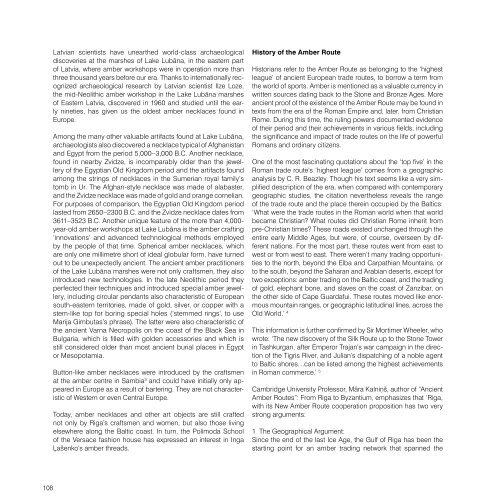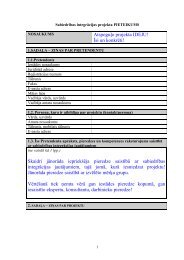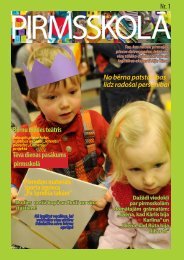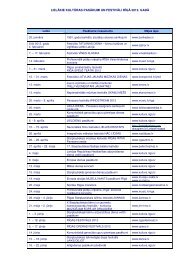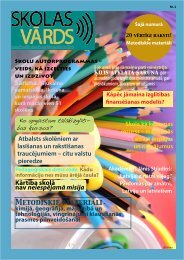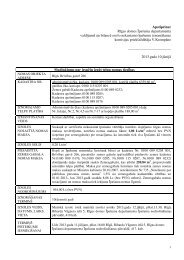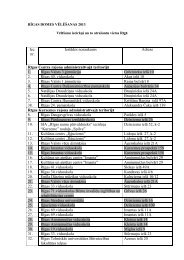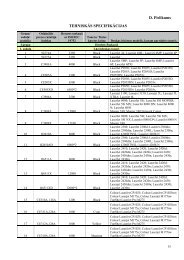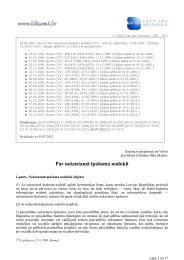Riga - European Capital of Culture 2014 candidate
Riga - European Capital of Culture 2014 candidate
Riga - European Capital of Culture 2014 candidate
- No tags were found...
You also want an ePaper? Increase the reach of your titles
YUMPU automatically turns print PDFs into web optimized ePapers that Google loves.
Latvian scientists have unearthed world-class archaeologicaldiscoveries at the marshes <strong>of</strong> Lake Lubāna, in the eastern part<strong>of</strong> Latvia, where amber workshops were in operation more thanthree thousand years before our era. Thanks to internationally recognizedarchaeological research by Latvian scientist Ilze Loze,the mid-Neolithic amber workshop in the Lake Lubāna marshes<strong>of</strong> Eastern Latvia, discovered in 1960 and studied until the earlynineties, has given us the oldest amber necklaces found inEurope.Among the many other valuable artifacts found at Lake Lubāna,archaeologists also discovered a necklace typical <strong>of</strong> Afghanistanand Egypt from the period 5,000–3,000 B.C. Another necklace,found in nearby Zvidze, is incomparably older than the jewellery<strong>of</strong> the Egyptian Old Kingdom period and the artifacts foundamong the strings <strong>of</strong> necklaces in the Sumerian royal family’stomb in Ur. The Afghan-style necklace was made <strong>of</strong> alabaster,and the Zvidze necklace was made <strong>of</strong> gold and orange cornelian.For purposes <strong>of</strong> comparison, the Egyptian Old Kingdom periodlasted from 2650–2300 B.C. and the Zvidze necklace dates from3611–3523 B.C. Another unique feature <strong>of</strong> the more than 4,000-year-old amber workshops at Lake Lubāna is the amber crafting‘innovations’ and advanced technological methods employedby the people <strong>of</strong> that time. Spherical amber necklaces, whichare only one millimetre short <strong>of</strong> ideal globular form, have turnedout to be unexpectedly ancient. The ancient amber practitioners<strong>of</strong> the Lake Lubāna marshes were not only craftsmen, they alsointroduced new technologies. In the late Neolithic period theyperfected their techniques and introduced special amber jewellery,including circular pendants also characteristic <strong>of</strong> <strong>European</strong>south-eastern territories, made <strong>of</strong> gold, silver, or copper with astem-like top for boring special holes (‘stemmed rings’, to useMarija Gimbutas’s phrase). The latter were also characteristic <strong>of</strong>the ancient Varna Necropolis on the coast <strong>of</strong> the Black Sea inBulgaria, which is filled with golden accessories and which isstill considered older than most ancient burial places in Egyptor Mesopotamia.Button-like amber necklaces were introduced by the craftsmenat the amber centre in Sambia 3 and could have initially only appearedin Europe as a result <strong>of</strong> bartering. They are not characteristic<strong>of</strong> Western or even Central Europe.Today, amber necklaces and other art objects are still craftednot only by <strong>Riga</strong>’s craftsmen and women, but also those livingelsewhere along the Baltic coast. In turn, the Polimoda School<strong>of</strong> the Versace fashion house has expressed an interest in IngaĻašenko’s amber threads.History <strong>of</strong> the Amber RouteHistorians refer to the Amber Route as belonging to the ‘highestleague’ <strong>of</strong> ancient <strong>European</strong> trade routes, to borrow a term fromthe world <strong>of</strong> sports. Amber is mentioned as a valuable currency inwritten sources dating back to the Stone and Bronze Ages. Moreancient pro<strong>of</strong> <strong>of</strong> the existence <strong>of</strong> the Amber Route may be found intexts from the era <strong>of</strong> the Roman Empire and, later, from ChristianRome. During this time, the ruling powers documented evidence<strong>of</strong> their period and their achievements in various fields, includingthe significance and impact <strong>of</strong> trade routes on the life <strong>of</strong> powerfulRomans and ordinary citizens.One <strong>of</strong> the most fascinating quotations about the ‘top five’ in theRoman trade route’s ‘highest league’ comes from a geographicanalysis by C. R. Beazley. Though his text seems like a very simplifieddescription <strong>of</strong> the era, when compared with contemporarygeographic studies, the citation nevertheless reveals the range<strong>of</strong> the trade route and the place therein occupied by the Baltics:‘What were the trade routes in the Roman world when that worldbecame Christian? What routes did Christian Rome inherit frompre-Christian times? These roads existed unchanged through theentire early Middle Ages, but were, <strong>of</strong> course, overseen by differentnations. For the most part, these routes went from east towest or from west to east. There weren’t many trading opportunitiesto the north, beyond the Elba and Carpathian Mountains, orto the south, beyond the Saharan and Arabian deserts, except fortwo exceptions: amber trading on the Baltic coast, and the trading<strong>of</strong> gold, elephant bone, and slaves on the coast <strong>of</strong> Zanzibar, onthe other side <strong>of</strong> Cape Guardafui. These routes moved like enormousmountain ranges, or geographic latitudinal lines, across theOld World.’ 4This information is further confirmed by Sir Mortimer Wheeler, whowrote: ‘The new discovery <strong>of</strong> the Silk Route up to the Stone Towerin Tashkurgan, after Emperor Trajan’s war campaign in the direction<strong>of</strong> the Tigris River, and Julian’s dispatching <strong>of</strong> a noble agentto Baltic shores…can be listed among the highest achievementsin Roman commerce.’ 5Cambridge University Pr<strong>of</strong>essor, Māra Kalniņš, author <strong>of</strong> “AncientAmber Routes”: From <strong>Riga</strong> to Byzantium, emphasizes that ‘<strong>Riga</strong>,with its New Amber Route cooperation proposition has two verystrong arguments:1 The Geographical Argument:Since the end <strong>of</strong> the last Ice Age, the Gulf <strong>of</strong> <strong>Riga</strong> has been thestarting point for an amber trading network that spanned theentire <strong>European</strong> continent and beyond. All cultures, civilizations,peoples desired the ‘sun-stone’ and the amber trade could beseen (quite legitimately) as the first example <strong>of</strong> a pan-<strong>European</strong>market, a kind <strong>of</strong> <strong>European</strong> Union (only the trade in flint occursearlier in human history).2 The Temporal Argument:Firstly, there is the documented importance <strong>of</strong> amber in historicaltimes from the 13 th century, when the Teutonic Knights secured amonopoly on the substance (which was so valuable that the revenuesfrom amber paid for the entire annual costs <strong>of</strong> the Order) tothe great Medieval and Renaissance amber guilds which createdwonders for the courts <strong>of</strong> princes and kings, popes and bishops,to modern times (e.g., the fabulous “Amber Room” <strong>of</strong> Peter the1Vaira Vīķe-Freiberga. Proceedings <strong>of</strong> the 4 th International Conference on Amberin Archaeology, Opening address, Talsi, Latvia, 2001//Latvian History InstitutePress, <strong>Riga</strong>, 2003.2Dr. Māra Kalniņš. Letter to the <strong>Riga</strong> application task group/20093Sambia (Semba, in Lithuanian, or Samland, in German), also known as theSambian Peninsula, was a Prussian territory on the peninsula between theCuronian Lagoon, the Baltic Sea, and the Prussian Lagoon (now the VistulaLagoon). Due to its wealth <strong>of</strong> amber and favorable geographical position, Sambiawas the first Prussian territory to become known to Western traders (Mugurēvičs,1995, pp. 24–27).4Beazley, C.R.. The Dawn <strong>of</strong> Modern Geography, vol. 1, p. 178 (London, 1897).5Sir Wheeler M. Rome beyond the Imperial Frontiers. London, 1954, p. 155.6Dr. Māra Kalniņš. Letter to the <strong>Riga</strong> application working group, 2009.Great and, in our own time, the wonderful Amber Altar in Gdansk,being made by Mariusz Drapikowski, which when completed willbe the largest amber artifact ever created, larger even than the“Amber Room”).Secondly, it is the story <strong>of</strong> Baltic amber in pre-history. (We alreadymentioned the great value that the Romans saw in amber and thejewel status it possessed in Greek, Minoan and Egyptian civilizations).Amber was, if anything, even more important in the StoneAge, to which research on amber workshops in Eastern Latvia,in the surroundings <strong>of</strong> Lake Lubāna, testifies. These workshopswere the crossroads between the western amber sources and theeastern (Moscow river basin) lands which produced flint 6 ”.108 109


